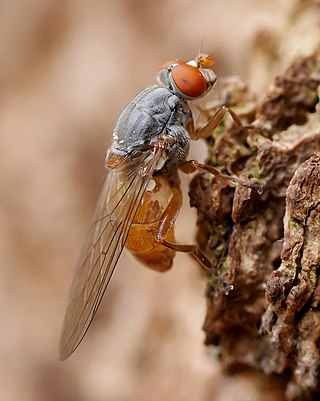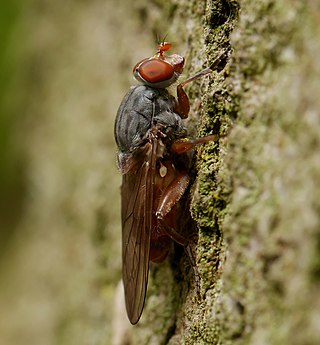
Eristalinae are one of the four subfamilies of the fly family Syrphidae, or hoverflies. A well-known species included in this subfamily is the dronefly, Eristalis tenax.

Brachyopa is a Holarctic genus of hoverflies whose grey and brown colouration is unusual for this family and these flies can easily be overlooked amongst members of other fly families. The larvae can be found under the bark of dead branches and trees in decaying sap.

Orthonevra is a genus of fly in the Syrphidae family with at least 59 species identified so far. They are worldwide in distribution but concentrated in the Eastern North America and Europe.Orthonevra are commonly called Mucksuckers after the larvae which have been found in organic rich mud, i.e. muck. This genus belongs to the tribe Brachyopini that includes the prominent genera Melanogaster, Brachyopa, Neoascia and Sphegina. Orthonevra have black heads with blue to purple reflections. Many species have distinctive eye stripes. The antennae are somewhat elongate. The frons is wrinkled with silvery spots at sides of antennae. The thorax with small punctures dorsally and in several species the body is covered with scale-like pile. Wingd vein M1 curves away from the wing tip.(see images)

The Brachyopini is a tribe of hoverflies. Unlike many members of this family these flies are generally darker and less colourful though some genera contain species with an attractive metallic lustre e.g. Chrysogaster. Some like Brachyopa are associated with sap runs where their larvae feed on decaying sap. Others are found in boggy areas where their often semiaquatic larvae feed on decaying organic matter.

Brachyopa insensilis is a Palearctic species of hoverflies.

Brachyopa scutellaris is a European species of hoverfly.

Brachyopa bicolor (Fallén, 1817) is an uncommon species of syrphid fly. It has been observed in Central Europe from Germany to Greece. Hoverflies get their names from the ability to remain nearly motionless while in flight. The adults are also known as flower flies for they are commonly found around and on flowers, from which they get both energy-giving nectar and protein-rich pollen. Larvae for this genus are of the rat-tailed type. B.bicolor larvae have been described from sap runs in Aesculus, Fagus and Quercus.
Hammerschmidtia ferruginea , the Aspen hover fly, is a rare, species of syrphid fly. It has been observed in Canada, Alaska and the northern United States. Hoverflies get their names from the ability to remain nearly motionless while in flight. The adults are also known as flower flies for they are commonly found around and on flowers, from which they get both energy-giving nectar and protein-rich pollen. Larvae for this genus are of the rat-tailed type. Hammerschmidtia ferruginea larvae have been described by Rotheray.
Brachyopa grunewaldensis is a European species of hoverflies.
Brachyopa bimaculosa is a European species of hoverflies.
Brachyopa silviae is a European species of hoverflies.
Brachyopa cinerea is a European species of hoverfly.
Brachyopa obscura is a European species of hoverflies.

Brachyopa panzeri is a European species of hoverflies.
Brachyopa plena is a European species of hoverfly.
Brachyopa tabarkensis is a European species of hoverflies.
Brachyopa cruriscutum is an Asian species of hoverfly.
Brachyopa minima is a European species of hoverfly.
Brachyopa vernalis is a species of hoverfly.






